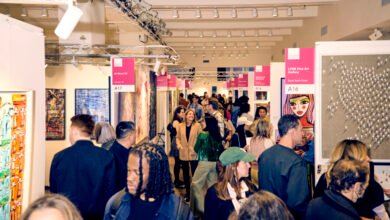Art and Augmented Reality: Enhancing The Gallery Experience

The fusion of art and augmented reality (AR) is a groundbreaking development. This technology is not just a tool but a new canvas, offering an innovative way to experience art. By adding digital elements to the physical world, AR invites a deeper interaction with the creations. It’s changing how we perceive and engage with things we see in galleries. This post delves into the transformative role of AR in showing exhibitions. It explores how AR enhances visitor experiences and opens new possibilities for all curators. As we explore this emerging landscape, we’ll discover how AR redefines the traditional boundaries of creativity and technology.
The Evolution of Galleries
Art galleries have experienced a remarkable evolution over the centuries. Originating as private collections accessible only to the elite, they have transitioned into public spaces that celebrate cultural diversity and creative expression. In earlier times, galleries were almost sacred places where silence prevailed, and the focus was solely on the physical works displayed in a traditional, static format. The advent of modern art initiated a shift towards more interactive and engaging experiences. These changes reflected the evolving societal attitudes towards creative works and their role in public discourse. Today, technology, especially augmented reality (AR), is playing a pivotal role in further transforming galleries. This technological integration introduces dynamic, immersive elements to all kinds of exhibitions, reshaping how audiences interact with them.

Uniboa for Unsplash
What is Augmented Reality?
Augmented Reality (AR) is a technology that overlays digital information into the real world. Unlike Virtual Reality (VR), which creates an entirely digital environment, AR enhances reality by adding to it. This technology has found applications in various fields, from gaming to education, and now it’s significantly impacting the creative world. AR in art is not just about viewing; it’s about experiencing and interacting. This technology allows visitors to engage with art in previously unimaginable ways. It brings paintings to life, tells stories behind sculptures, and creates immersive environments. AR is transforming it from a passive viewing experience into an interactive journey, making art more accessible and appealing to a broader audience.

Dannie Jing for Unsplash
Augmented Reality in Galleries
In the realm of art and augmented reality, galleries are finding new ways to captivate and engage their audiences. By integrating AR, traditional creative works are no longer confined to their frames. Visitors can interact with different pieces, uncovering hidden stories and details. This interaction is not just about adding novelty but deepening understanding. AR allows curators to express concepts and narratives that extend beyond the physical dimensions of their work. For galleries, this means offering a more engaging and memorable experience. This new dimension of interaction attracts diverse audiences, including those who might not have been interested in traditional forms of creativity. AR is thus enhancing the gallery experience and democratizing access to art for everyone.
Benefits of Integrating AR
Integrating AR into art galleries offers numerous benefits. Firstly, it significantly enhances the visitor experience. By adding interactive elements, AR makes art more engaging and understandable. It also serves as an educational tool, providing contextual information and historical background about works people see. This can be particularly beneficial for complex or abstract pieces. Moreover, AR contributes to making art more inclusive. It breaks down barriers for those who might feel intimidated by traditional galleries. It also offers accessibility features for people with disabilities. For creatives, AR is a powerful medium for creative expression. It allows them to add layers of meaning and interaction to their works. This technological integration enriches the art and broadens its appeal, attracting a wider, more diverse audience.
Challenges and Considerations
Despite its benefits, integrating AR in galleries is not without challenges. The foremost is the technical and financial investment required. Not all galleries have the resources to implement AR technology effectively. Another challenge is finding the right balance between technology and creative works. There’s a risk that the technology might overshadow the art itself. Curators must ensure that AR complements, rather than dominates, the creative experience. Accessibility is another crucial consideration. The technology should be user-friendly and accessible to all visitors, regardless of their tech-savviness. These challenges require careful planning and thoughtful implementation. Success in this venture means not just adopting new technology but adapting it in a way that respects and enhances the core values of the gallery.

Tara Winstead for Pexels
Art and Augmented Reality: The Future of Galleries
The future of art galleries with augmented reality is promising and full of potential. As AR technology advances, its applications within galleries will likely become more innovative and immersive. We can expect galleries to offer experiences that are not only visually stunning but also emotionally engaging and intellectually stimulating. These developments will likely attract a new generation of artists and visitors for whom technology is integral to life. As AR becomes more mainstream, it may also become a key factor in conceptualizing and creating new artworks. The gallery of the future might be a place where the boundaries between reality and digital creation are seamlessly blended, offering experiences that are currently unimaginable.
Conclusion
The blend of art and augmented reality (AR) marks a pivotal moment in the evolution of galleries. This technology is not just a passing trend but a revolutionary shift in how we experience and interact with works in the gallery. AR brings a new dimension to exhibitions, allowing visitors to engage with creations on a deeper, more interactive level. This enhanced engagement is vital for the modern audience, who seek experiences that are both intellectually stimulating and emotionally resonant. As AR technology continues to develop, its potential applications are boundless. We can anticipate more immersive, personalized, and interactive experiences that challenge our traditional perceptions of art. As we embrace this new era, the marriage of art and AR promises to enrich our cultural landscape, making it more accessible, engaging, and meaningful for everyone.
___________________________________
Author Bio:
Emily Hart is a freelance writer and art enthusiast in Seattle, Washington. Emily’s journey in the art world began with her first job at PortaBox Storage Washington, where she oversaw the storage of various art pieces and antiques. This role gave her unique insights into the logistical aspects of art preservation and sparked her interest in how art interacts with different spaces and environments.
Source link



